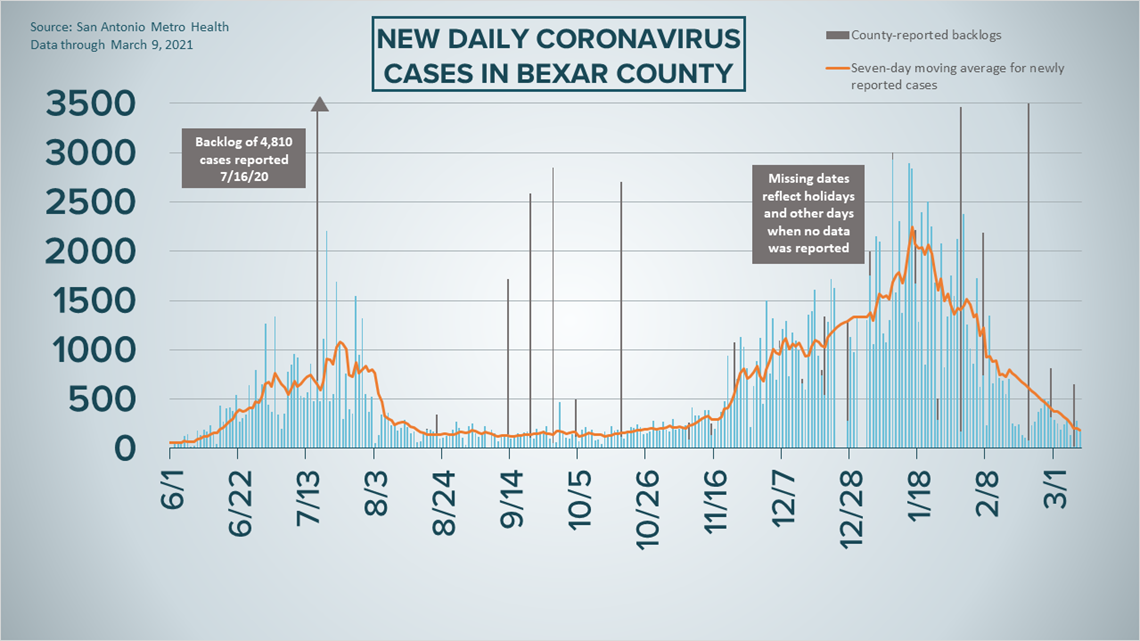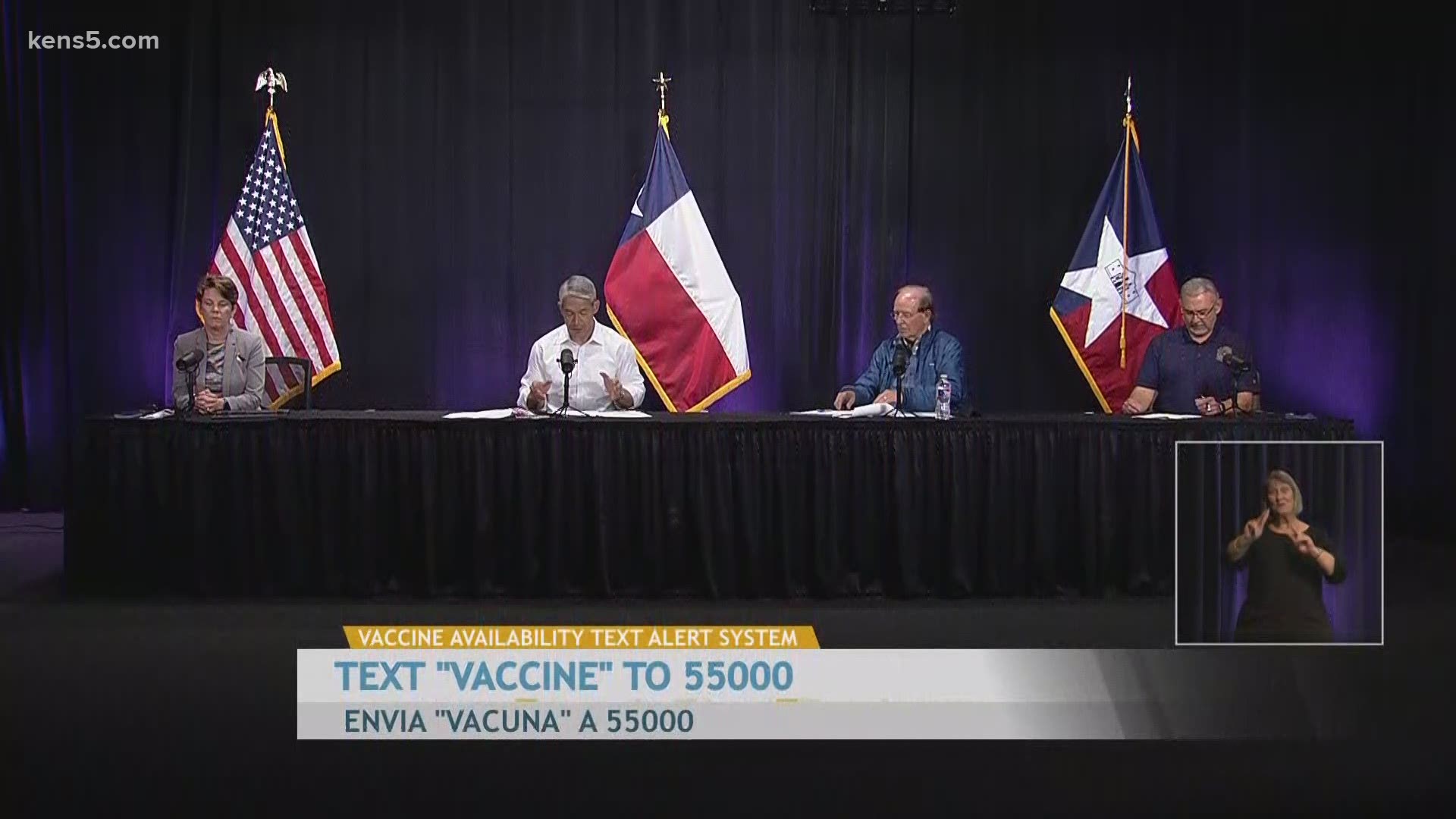SAN ANTONIO — We're tracking the latest numbers from the coronavirus pandemic in San Antonio and across Texas. Here are the latest numbers reported by Bexar and surrounding counties:
- Bexar County: On Tuesday, 171 new cases were reported, bringing the total number of cases to 198,969. Six deaths were reported, raising the local death toll from virus complications to 2,853.
- Hays County: On Tuesday, officials reported 18 new cases in the county and no additional COVID-related fatalities. There is now a total of 16,592 lab-confirmed local cases, while the death toll remained at 229. Officials estimate 15,804 residents have recovered, while 559 are still ill with the virus.
- Comal County: Officials reported 38 new cases on Tuesday, along with four additional virus-related deaths. As of Tuesday, 9,346 total COVID-19 cases have been reported, including 4,930 confirmed and 4,396 probable cases, while 298 county residents have died due to COVID-19 complications.
More county case information is available through the Texas Department of Health Services COVID-19 dashboard.
How Bexar County is trending
We've tracked how many coronavirus cases have been confirmed in Bexar County from the time officials began reporting cases in March 2020. The graphic below shows the number of cases since June and charts those daily case numbers along a 7-day moving average to provide a more accurate picture of the overall coronavirus case curve in our area and the direction we're trending amid the pandemic.
On Tuesday, San Antonio Mayor Ron Nirenberg reported 171 additional coronavirus cases in Bexar County, raising the local total to 198,969 cases since the pandemic began. The seven-day rolling case average continues to decrease, this time to 186.
Nirenberg also reported six more virus-related deaths. In all, 2,853 Bexar County residents have died from coronavirus complications.


Hospitalizations continued to fall in Bexar County on Tuesday, decreasing to 262 COVID-19 patients at area hospitals. It's the lowest that number has been since November.
Of those 262 patients, 76 are using ventilators and 120 are in intensive care.


Coronavirus in Texas
The total number of novel coronavirus cases in the state since the pandemic began grew by 5,313 on Tuesday, according to the Texas Department of State Health Services. That total includes 3,744 new confirmed cases, 1,063 new probable cases, and a backlog of 506 cases. More details can be found on this page.
Tuesday's figures bring the total number of Texans diagnosed with COVID-19 to more than 2.694 million.


Meanwhile, state health authorities reported an additional 167 deaths from coronavirus complications in Texas. In all, 44,650 Texans have died from COVID-19.
While Texas hospitalizations have largely been on a downward trend since mid-January, the figure on Tuesday saw its biggest jump since that time, increasing by 373 to 4,702 COVID-19 patients receiving treatment for their symptoms across the state. That's an 8.6% jump over Monday.
The state, meanwhile, estimates that about 2.518 million Texans have recovered, while 128,614 Texans remain ill with COVID-19.
The latest update from the Texas Education Agency showed that there have been at least 190,308 cumulative cases among staff and students on Texas public school campuses through Feb. 28. That number comprises 123,875 positive student cases and 66,433 staff cases. More information can be found here.
The TEA typically releases new data on school cases on Fridays.
Latest Coronavirus Headlines
- 100 SAISD employees vaccinated against COVID-19, kicking off local effort to immunize school staff
- How did we get here? A look back at a year of COVID-19 in San Antonio
- COVID vaccine: How many people in Bexar County have received a shot?
- COVID-19 Vaccine Tracker: Fast facts and how to participate in Phase 1B distribution in San Antonio
- Third stimulus check update: House plans to vote Wednesday on COVID-19 relief
- Texas has fallen behind in a nationwide look at vaccine distribution — Here's why.
- Spring break on South Padre Island expected to be smaller due to COVID as businesses ramp back up
- VERIFY: Most of the COVID relief bill is directed toward COVID-related things
Coronavirus symptoms
The symptoms of coronavirus can be similar to the flu or a bad cold. Symptoms include fever or chills, cough, shortness of breath or difficulty breathing, fatigue, muscle or body aches, headache, new loss of taste or smell sore throat, congestion or runny nose, nausea or vomiting, and diarrhea, according to the Centers for Disease Control.
Most healthy people will have mild symptoms. A study of more than 72,000 patients by the Centers for Disease Control in China showed 80 percent of the cases there were mild.
But infections can cause pneumonia, severe acute respiratory syndrome, kidney failure, and even death, according to the World Health Organization. Older people with underlying health conditions are most at risk.
Experts determined there was consistent evidence these conditions increase a person's risk, regardless of age:
- Chronic kidney disease
- COPD (chronic obstructive pulmonary disease)
- Obesity (BMI of 30 or higher)
- Immunocompromised state (weakened immune system) from solid organ transplant
- Serious heart conditions, such as heart failure, coronary artery disease, or cardiomyopathies
- Sickle cell disease
- Type 2 diabetes
The CDC believes symptoms may appear anywhere from two to 14 days after being exposed.
Human coronaviruses are usually spread...
- Between people who are in close contact with one another (within about 6 feet).
- Through respiratory droplets produced when an infected person coughs, sneezes or talks. These droplets can land in the mouths or noses of people who are nearby or possibly be inhaled into the lungs.
- Some recent studies have suggested that COVID-19 may be spread by people who are not showing symptoms.
Help stop the spread of coronavirus
- Stay home when you are sick.
- Eat and sleep separately from your family members
- Use different utensils and dishes
- Cover your cough or sneeze with your arm, not your hand.
- If you use a tissue, throw it in the trash.
Find a Testing Location
City officials recommend getting a COVID-19 test if you experience fever or chills, cough, shortness of breath or difficulty breathing, fatigue, muscle or body aches, headache, new loss of taste or smell, sore throat, congestion or runny nose, nausea or vomiting, or diarrhea.
A self-screening tool is available to see if you need a test.
Here's a Testing Sites Locator to help you find the testing location closest to you in San Antonio.

